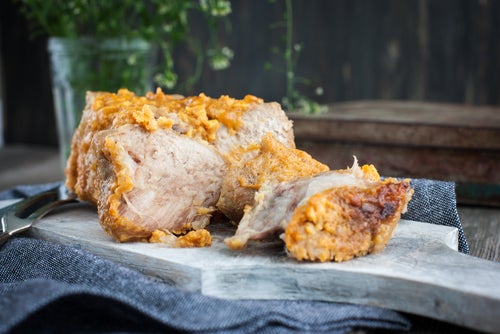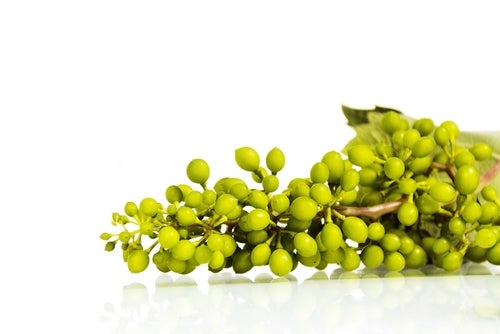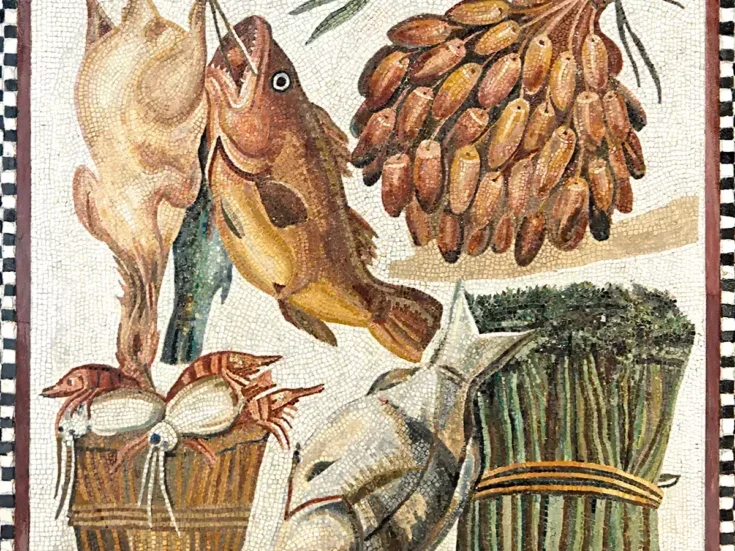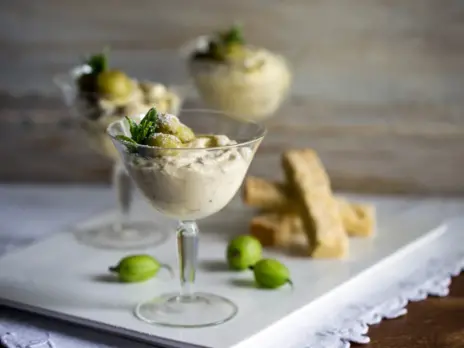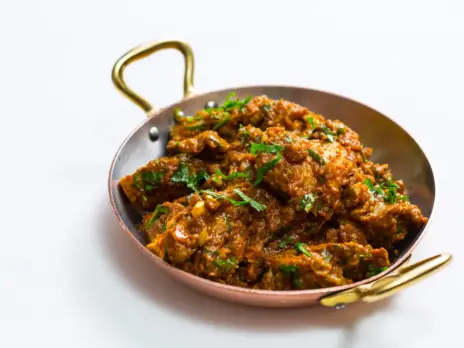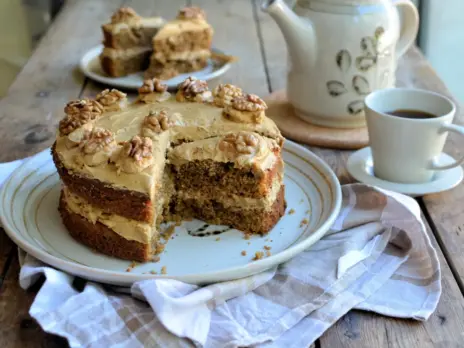
One of the most distinctive and evocative features of a traditional torta pasqualina, Liguria’s popular Eastertide savory pie, is that it was made with 33 layers of pastry, one for each year of Christ’s life. Colman Andrews, in his fascinating Flavours of the Riviera (2000, Grub Street), even specifies 10 underneath and 23 on top, although he says this “is almost possible to find today” and his recipe uses “7 or 8 sheets […] 3 for the top.”
Touching though the idea is, the 33 appears to be the stuff of legend not authenticity, but the rest of the dish, a pie in which several sheets of the thinnest possible pastry enclose vegetables, fresh cheese and eggs in separate layers, has been a Ligurian speciality, served cold at Easter, for centuries.
In the mid-15th century, in the Libro de arte coquinaria, Martino de’ Rossi da Como talked of torta all Zenovesa di spinach o di cepolle (Genoese torta of spinach or onion). In the following century, vegetable torte became known as gattafura and two recipes for gattafura alla Genovese, one using chard and one with onions, were included in the Opera di Bartolomeo Scappi, mastro dell’arte del cucinare. (Scappi, the Renaissance equivalent of an international celebrity chef, was chef to various cardinals, then to popes Pius IV and Pius V, and his tome, published in 1570, is regarded as the first illustrated cookbook.)
In the 18th century, the term gattafura was gradually replaced by torta pasqualina and by 1863, in the Genoese culinary bible La cuciniera genovese, a detailed recipe distinguishes torta pasqualina from other vegetable pies, describing its filling as having, first, a layer of chard, then prescinsêua (a soft, lightly acidic, fresh cheese from Genoa), then other vegetables bound with egg, grated cheese, and aromatic herbs.
How to make torta pasqualina
This is very like the contemporary recipe—or would be if there were not many variations, according to exact locality, personal preference, and the seasonality of vegetables. While almost all recipes agree on the inclusion of some sautéd onion, the main vegetable, chard, is often replaced by spinach, all or in part, and occasionally baby artichokes, newly in season, are used instead.
As prescinsêua is hard to find outside the province of Genoa, many people use ricotta instead, often mixed with some Greek yogurt (I use five parts ricotta to one of yogurt), and some people make their own prescinsêua by heating full-fat milk with some yogurt and rennet, leaving it for around 20 hours, then draining it (you can find the recipe online).
Herbs and spices vary, although marjoram and nutmeg are widely used. There is also an old Italian spice blend called La Saporita, which includes coriander seeds, cinnamon, cloves, nutmeg, caraway seeds, and star anise, which was used by Enrichetta Trucco, revered as the queen of traditional Ligurian cooking and not least of torta pasqualina.
Eggs are a moot point. In addition to egg or egg white often used in binding the vegetable layers, most recipes include between four and six whole, shelled eggs (or sometimes just the yolk), carefully placed in indentations made in the uppermost layer of filling. As it’s an Easter dish, this sounds traditional and the yellow yolks contrast attractively against the filling when the pie is cut into wedges, but Enrichetta Trucco was adamant that eggs were not essential (I always include them).
As for the 33 pastry layers, this appears to be a relatively recent invention and one of no fixed date or recipe. I eventually found a recipe with the legendary number in European Festival Food by Elizabeth Luard (1990), but Signora Trucco had no truck with so many. During her long career she said she made only one torta pasqualina with 33 layers and that was at the specific request of a customer.
What is traditional is very thin pastry, the most economical of all made with flour, water, salt and only a very little olive oil, if any. Inland from the glamorous Riviera, Liguria is mountainous and wooded. It was a poor region with little land for grain growing or animal grazing. Wheat was expensive, so pasta was a rarity; hence the torta pastry rolled and stretched almost to transparency and hence the many homemade vegetable-based fillings, of which torta pasqualina’s is the most celebrated. Recipes since the 1990s have often suggested bought filo pastry, which I find satisfactory when necessary. A few suggest puff pastry as an alternative, but this is mostly considered beyond the pale for this particular torta.
All recipes should amount to more than the sum of their parts, but torta pasqualina seems to me to amount to hugely more, with its harmony of leafy freshness and slight bitterness from the chard/spinach set against the sweetness of a small proportion of cooked onion (and the sweetness of nutmeg, if used), the tang and creaminess of the cheese, the gentle richness of the egg yolk, and the seasoning of fresh herbs and spices, all encased in very fine pastry layers.
The best wines to pair with torta pasqualina
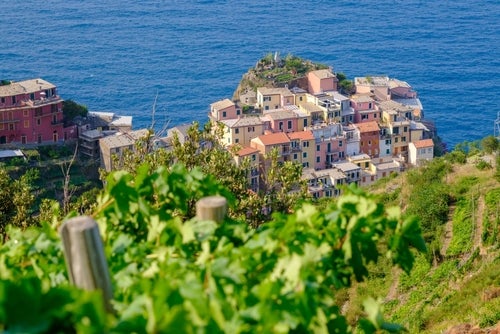
Torta pasqualina is not a challenging dish for wine, or, at least, there are plenty of choices among white wines, fewer among rosés, and fewer again among reds. If you want to take the red route, think in terms of fairly light-bodied, fresh wines with subtle fruit (more red than black) and very little perceptible tannin or oak. A Bardolino, for example from Cantina Menegotti; a Trentino or Alto Adige Schiava, such as Cum Vineis Schiava; a South African Cinsault or Domaine des Tourelles Cinsault Vieilles Vignes from the Bekaa Valley; an old-vine Chilean País; or a savory, rather than fruity, Pinot Noir.
Bardolino also steps in with rosé in a wine such as Monte del Frà Chiaretto di Bardolino. Another good Italian rosé pairing would be the lees-aged La Calcinara Mun Rosato made from Montepulciano in the Marche. The more gastronomic styles of Provence rosé also have much to offer, such as Léoube’s top of the range Collector.
The range of white wines that pair with torta pasqualina is wide but largely occupies the middle ground: medium body with moderate rather than high acidity; fruit that isn’t too assertive/sweet and is balanced by other accents such as herbs, spiciness, and stony or salty minerality; a positive texture from, for example, lees ageing or fermentation in concrete eggs; and oak, if involved, that is low key.
In Liguria, I would drink the local Pigato or Vermentino (both names are used), but I’m not rushing to this grape variety otherwise, except perhaps for Grattamacco Bolgheri Vermentino with a few years’ bottle age. I am even less likely to choose a Riesling or Sauvignon Blanc. That said mature, oak-fermented blends of Semillon and Sauvignon can work (I am thinking of Graves such as Château Chantegrive Cuvée Caroline).
Among the many white wines and grape varieties to consider are Lugana (Cà dei Frati, for example), Soave Classico, Pinot Bianco (especially from Cantina Terlano), Fiano (a producer such as Luigi Maffini), Grüner Veltliner, Godello, Muscadet (especially from Jérémie Huchet), and Chardonnay from Burgundy, including the Mâconnais and old-vine Beaujolais Blanc, and cool-climate regions such as Mornington Peninsula (Kooyong to name but one in this high-flying peninsula), Oregon, Santa Barbara County, and New Zealand. Long as the list is, it’s by no means exhaustive, but if optional paralysis threatens, go for traditional-method sparkling from Champagne, Franciacorta, or England. It adds to the pleasure of torta pasqualina.

